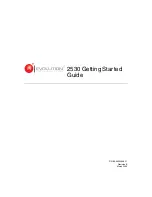
7914support2-0209.fm
Draft Document for Review March 28, 2011 12:24 pm
402
IBM System Storage DS3500: Introduction and Implementation Guide
14.8 Import/Export Array
The DS3500 storage subsystem has the ability to export and import arrays which enables you
to safely move arrays between different DS3500 systems without losing application data.
This is very helpful when you have to upgrade or replace a DS3500 system with a newer
model, or faster disks, but want to preserve the expansions and their data.
The export/import function checks that all the conditions to support the disk migration are met
before placing the disks offline and allowing removal of the physical disks from the enclosure.
14.8.1 Export Array
The export array operation prepares the disk drives in the array for removal. You can remove
the disk drives for offline storage, or you can import the array to a different DS3500 storage
subsystem. After you complete the export array operation, all of the disk drives are offline.
Any logical drives or free capacity associated with the exported array are no longer shown in
the storage management software.
Export Array prerequisites
In this section we describe all of the prerequisites that must be completed before you can
export an array.
You must remove any non-exportable components before you can start the export array
procedure. You must remove these components for each array that you want to export:
– Host-to-logical drive mappings
– VolumeCopy pairs
– FlashCopy logical drives and FlashCopy repository logical drives
Exporting an array includes following these steps on the source storage subsystem:
– Save the storage subsystem configuration. This is a precaution to help you restore your
configuration in the event of a problem during the export.
– Back up the data on the logical drives in the array. Stop all I/O, and unmount or
disconnect the file systems on all the logical drives in the exported array.
– Locate the array, and label the disk drives. Use the locate array function to flash the
LEDs on the drives in the array, and then label them with the source and destination
storage subsystem names, array name, and total number of drives in the array.
– Obtain blank disk drive CRUs or new disk drives. Upon removing the drives in the array,
you must replace them with blank drive canisters or new drives to maintain proper
airflow within the enclosure
Exporting an array includes these steps on the target storage subsystem:
– Make sure that the target storage subsystem has enough available empty disk drive
slots for the number of drives that you will be importing.
– Make sure that the target storage subsystem supports the type of disk drives that you
will import. You must also ensure that you do not exceed the maximum number of
drives supported by the storage subsystem.
– Make sure that the target storage subsystem can support the new logical drives. The
storage subsystem must support the RAID level of the array you are exporting and you
Important: You should always ensure that the source and destination DS3500 storage
subsystems are running the same firmware levels before starting this procedure. We
recommend upgrading both the source and the destination DS3500 subsystems to the
latest firmware available before attempting any disk migration.
Summary of Contents for DS3500
Page 2: ......
Page 5: ...iii Draft Document for Review March 28 2011 12 24 pm 7914edno fm ...
Page 789: ......
















































